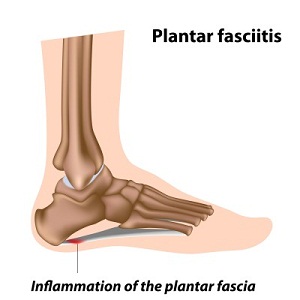Most bodily injuries produce pain when you place weight down on the body part that is injured, but plantar fasciitis is a bit different. It actually produces pain after an extended period of rest. When you get up and start moving again it will hurt for a short period of time, but then will go away.
Due to this nature of the injury, it is often identified by pain first thing in the morning when you first step out of bed from a long night of rest.
Since the feet take a beating during intense running sessions, this is a rather common injury for runners to endure.
Plantar Fasciitis Explained

The plantar fascia is a section of thick tissue that stretches between the heel of the foot and the arch of the foot. It goes along the bottom of the foot in the back and is designed to support the arch of the foot when in motion.
This is not a very flexible section of tissue, but it is designed to move just a little when the foot is flexed or stretched. This is how it absorbs some of the tension from the foot hitting the ground.
It is very easy to see how this band of tissue could become injured by running, since the foot flexes and hits the ground over and over during this activity. When this is more than the tissue can handle, small tears can take place and that leads to the pain known as plantar fasciitis.
The problem is that this condition can be mixed up with a variety of other injuries that are associated with the tissues of the foot. For example, heel spurs and heel pain syndrome may be commonly confused with a diagnosis of plantar fasciitis.
To know for sure what is causing the pain, a runner would have to seek medical attention for a proper diagnosis. Even then, it can be difficult to narrow it down to the accurate diagnosis.
Common Causes
Anytime the tissues of the plantar fascia are overextended or irritated, plantar fasciitis can be the result. This is especially common in people who flex and point the foot a lot, such as serious runners who go out for very long runs.
Those who gain weight suddenly will put more pressure down on the arch of the foot and that may also lead to a diagnosis of plantar fasciitis.
Those with high feet, high arches, or those who tend to overpronate may be at increased risk of developing this injury. It is the way their feet hit the ground and the way this band of tissue is forced to move and stretch that makes them at high risk for injury.
Plantar Fasciitis Treatment Options
There really is not much that can be done to heal this condition. Runners who suffer the injury must take some time off their feet to allow the injury to heel.
If the pain is severe, over-the-counter medication can be used to keep the sufferer more comfortable. Gently massaging the bottom of the foot may help to ease the muscle and the pain that comes with the injury.
Putting ice on the injury may help to reduce any swelling and may help a little bit with the pain as well. Some sufferers will use foam rollers or rolled up towels to gently apply pressure on the foot similar to a massage.
There are night splints that hold the foot in a steady flexed position. Many people will use these splints to help the foot feel better at night and speed up the healing process.
There may be other products on the market that can help the foot stay in place during the day so faster recovery may be experienced. As the pain goes away, light activity can be resumed.
How to Prevent
There are some exercises that can be used to strengthen the tissues of the plantar fascia. Regular stretching may also be used to keep the tissue as flexible as possible.
Runners who overpronate or with other signs of high risk must make sure their shoes are as supportive as possible so less pressure is placed on the arch of the foot.
There are no clear ways to ensure you do not experience plantar fasciitis in the future. Keeping the lower body strong and maintaining proper running form is a good way to lower your risk.
Do you want to get more tips on how to prevent and cope with running injuries? You should give Running Doc’s Guide to Healthy Running, written by Lewis Maharam, definitely a try!
Recommended further reading:
- How to prevent achilles tendonitis
- How to prevent ankle sprains
- How to prevent blisters
- How to prevent DOMS
- How to prevent hamstring injuries
- How to prevent muscle cramps
- How to prevent overtraining syndrome
- How to prevent shin splints
- How to prevent stress fractures
Return from Plantar Fasciitis to Running Injuries
Return to Marathon Training Tips home
